
Mohammed Bey or M'hamed Bey was the eleventh Husainid Bey of Tunis, ruling from 1855 until his death. He was the son of Al-Husayn II ibn Mahmud and his second wife Lalla Fatima al-Munastiri.
Mahmoud Djellouli (1755–1839) was a trader and Tunisian diplomat. He was a member of the same clan as Youssef Saheb Ettabaa and among the important figures of his time.

Mohammed Aziz Djellouli was a Tunisian politician and businessman. He served for a time as chairman of the Red Crescent in Tunisia, and an administrator of the Central Bank of Tunisia under Hédi Nouira.

Dar Bayram is an old palace located in the Andalusians Street, in the medina of Tunis. It is indexed as one of the biggest historical residences of Tunis, in the inventory of Jacques Revault, member of the Middle East and Mediterranean Studies Research Group.

Dar Ben Ayed is an old palace of the medina of Tunis. It is located in the Ben Ayed Street in Bab Jedid, near Tourbet el Bey and Souk Es Sabbaghine.
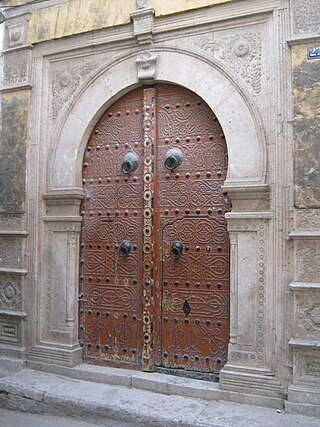
Dar Balma is an old palace in the medina of Tunis.

Dar Al Jaziri is a palace in the medina of Tunis. Located in the Tribunal Street, a few meters from Dar Lasram, it was one of the residences of the Jaziri family between the 12th and 18th centuries.
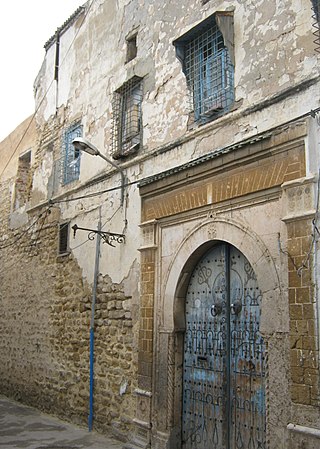
Dar Ibn Abi Dhiaf is a palace in the medina of Tunis, located near the Pasha Street and Sidi Mahrez Mosque, in the Ibn Abi Diaf dead end.

Dar El Haddad is one of the oldest palaces in the medina of Tunis.

Dar Lasram is one of the palaces of the medina of Tunis. It is located at 24 Tribunal Street.

Dar Bou Hachem is a palace in the medina of Tunis.
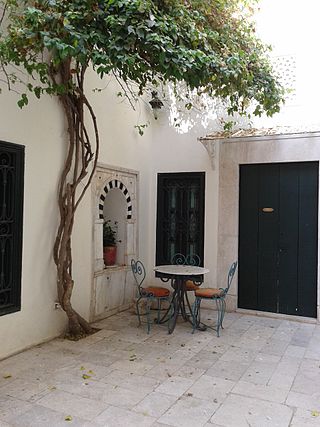
Dar Belhouane is a palace in the medina of Tunis, located at 64 Sidi Ben Arous Street. Today, it operates as a guest house.

Dar Caïd Nessim Samama is one of the palaces of the medina of Tunis.

Dar Zarrouk is one of the palaces of the old town of Tunis. It is one of the largest historical palaces in Tunis.
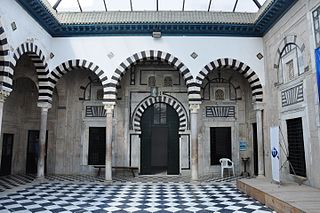
Dar Daouletli is an old palace in the medina of Tunis.
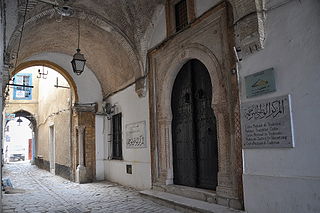
Dar El Monastiri is a palace in the Medina of Tunis.

Dar El Cherif is an old palace in the Medina of Tunis. It is located in Sidi Maaouia Street, near El Monastiri and Achour Streets.

Dar Aziza is a 16th-century Moorish palace located in the Casbah of Algiers in Algeria. Today, it houses the National Agency of Archaeology and Protection of Historic Sites and Monuments. Dar Aziza, arguably the most iconic surviving building of its era in Algiers, was part of a large governmental compound known as Janina Palace, which existed before the arrival of Turkish corsairs.

Dar Moqri is a historic palace or group of mansions in Fes el-Bali, the old medina of Fes, Morocco. It dates from the late 19th and early 20th centuries and was built by the wealthy and powerful Moqri family. The site is occupied by two grand residences built separately by members of the same family but physically adjoining each other. The older palace was begun by Abdelsalam al-Moqri and probably further modified by his son Muhammad. In addition to its rich interior, it is notable for its large terraced garden. The second palace belonged to his grandson Si Tayb and is notable for its long courtyard which mixes Italianate details with traditional Moroccan decoration. A completely separate palace, known as Riad Driss Moqri, was also built further north by Abdelsalam's son, Si Dris.

Dar Glaoui or Glaoui Palace is a late 19th-century and early 20th-century palace in Fez, Morocco. It was owned by the Glaoui family, whose most famous members were the Grand Vizier Madani and his brother Thami, pasha of Marrakech. The palace is located in the southwestern district of Fes el-Bali, in an area containing other historic mansions.



















